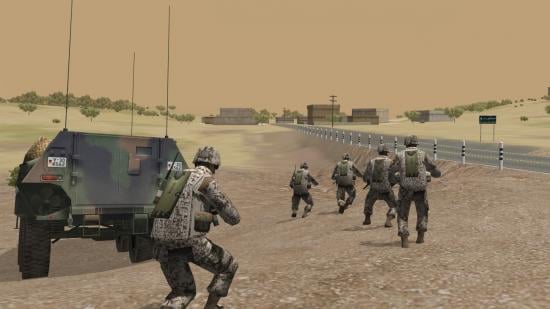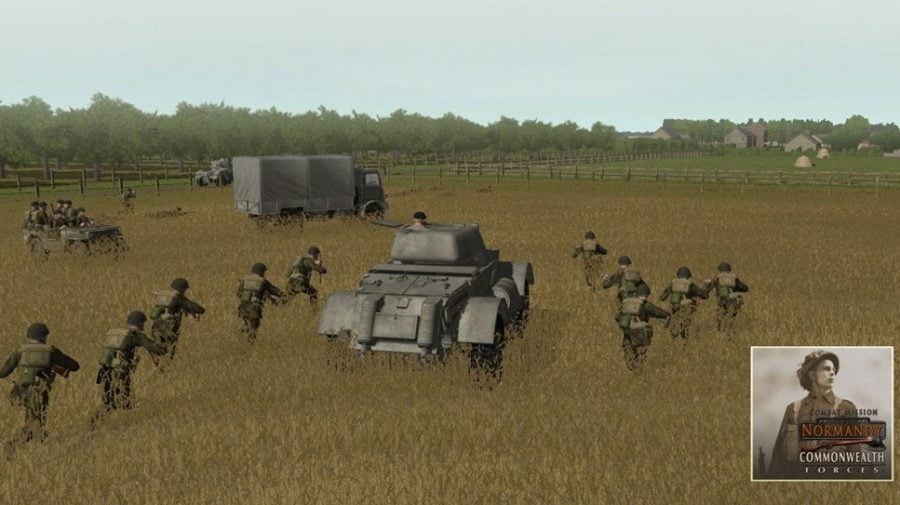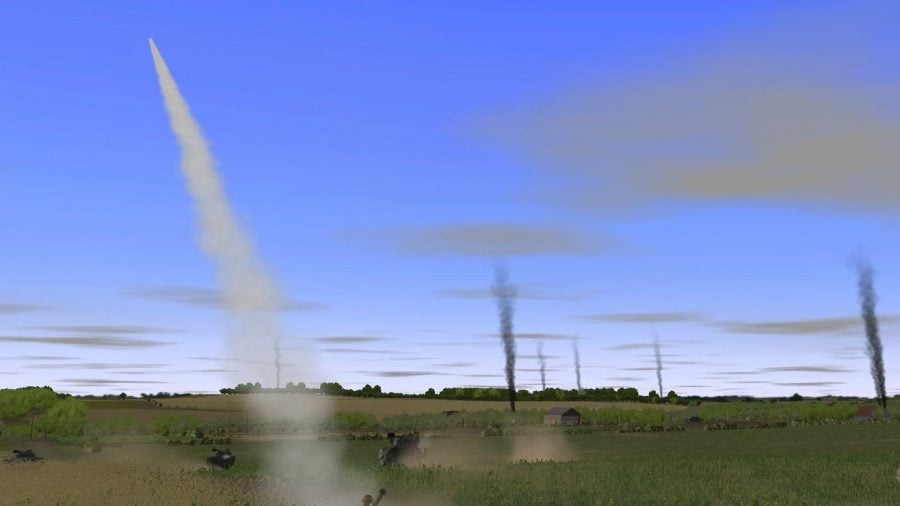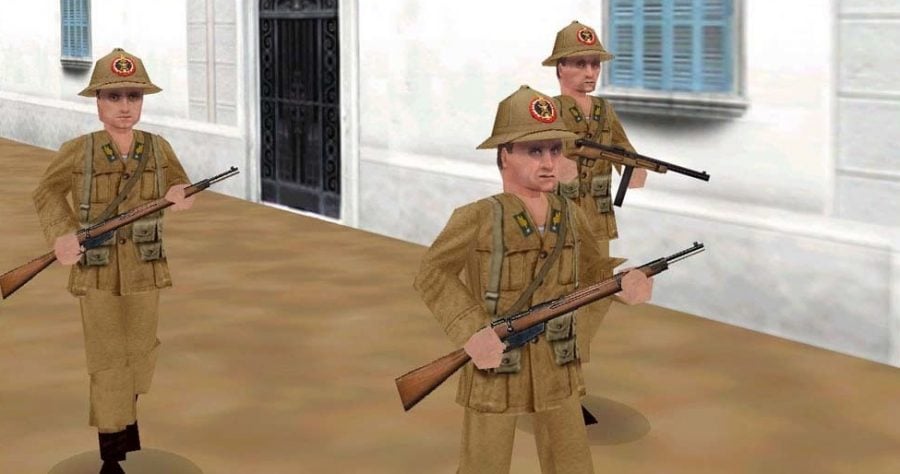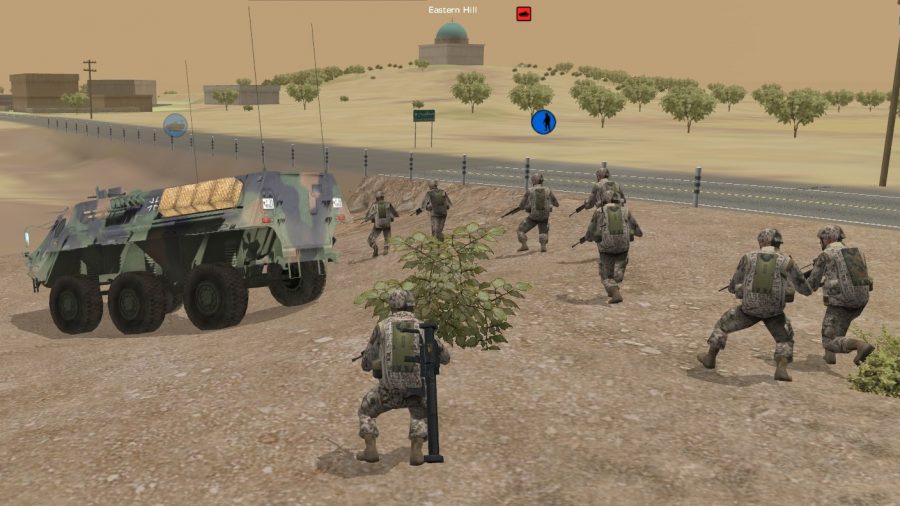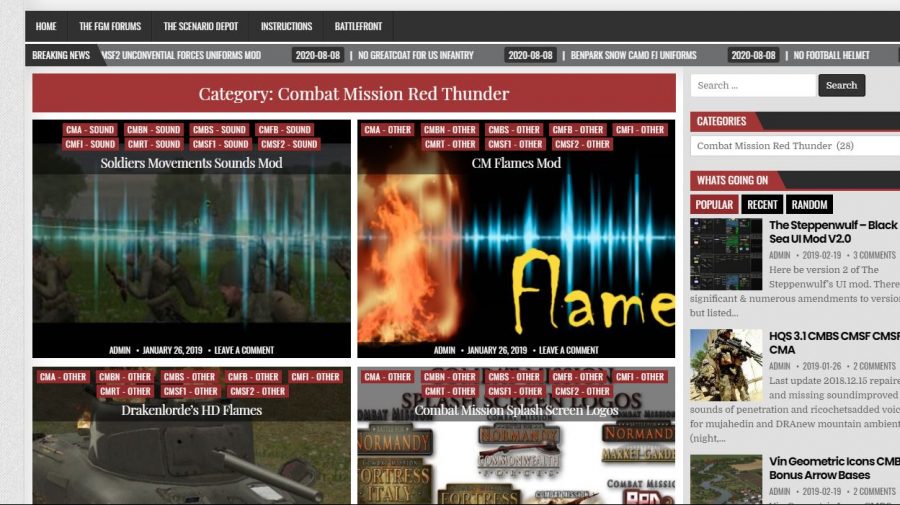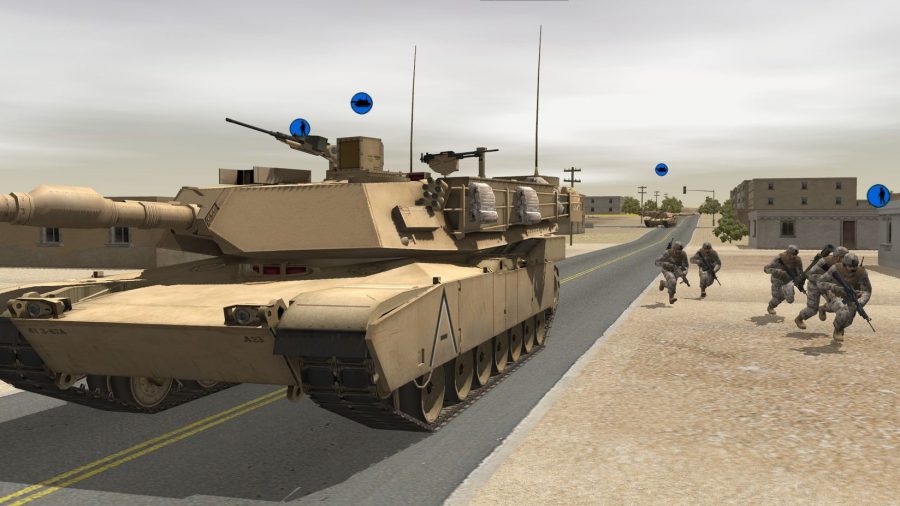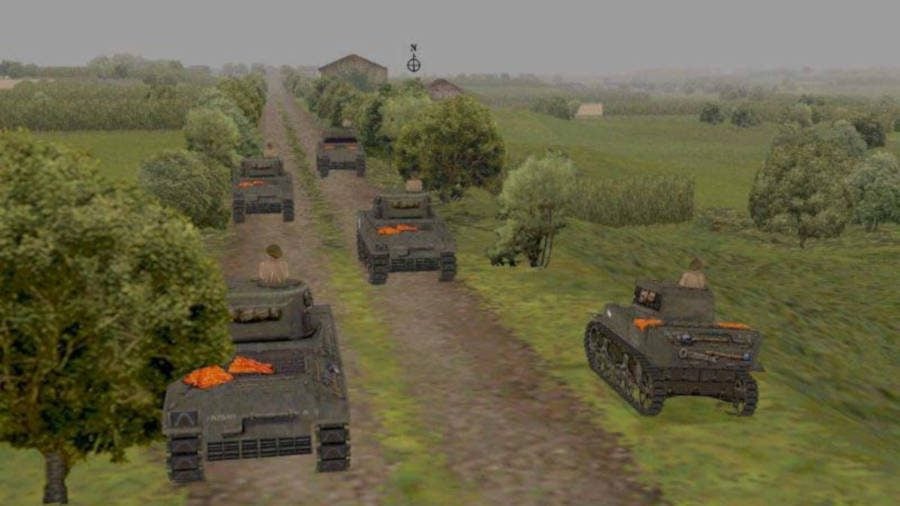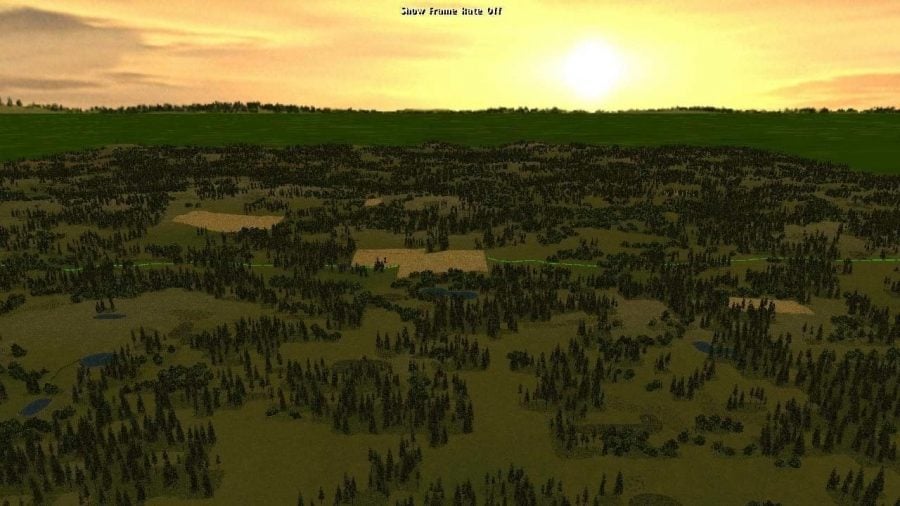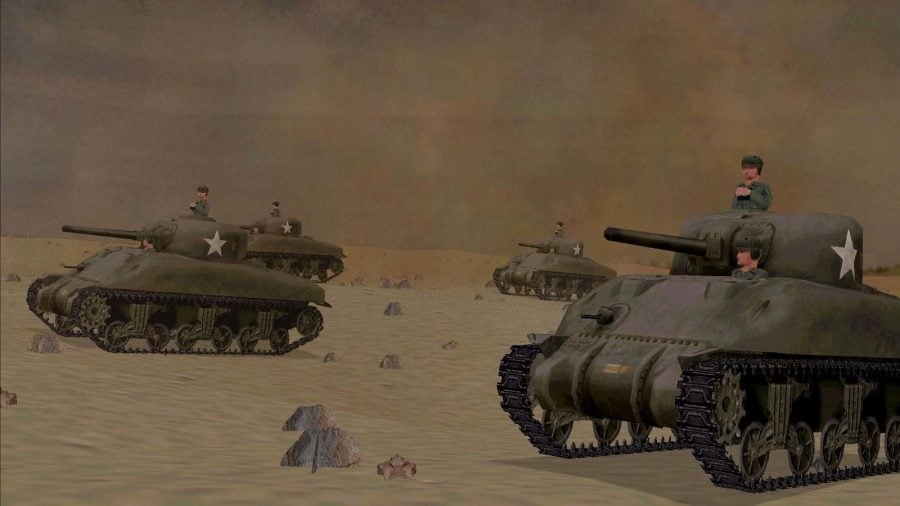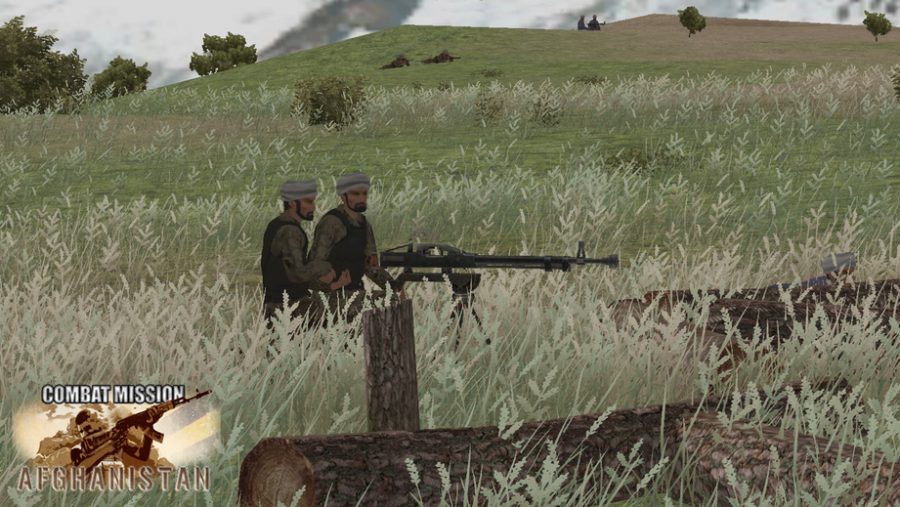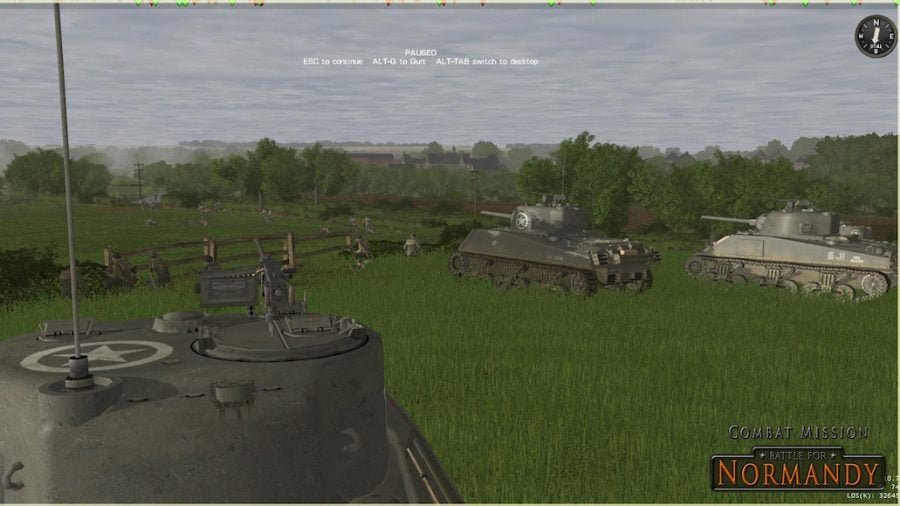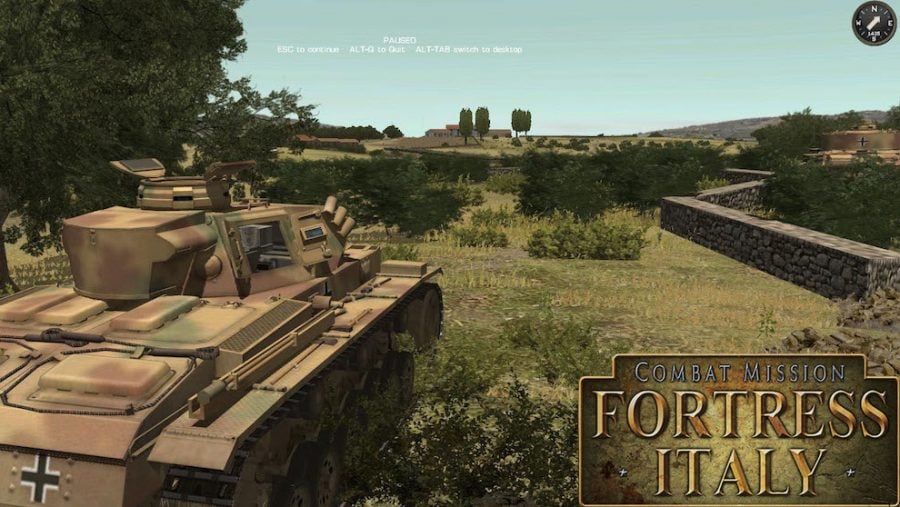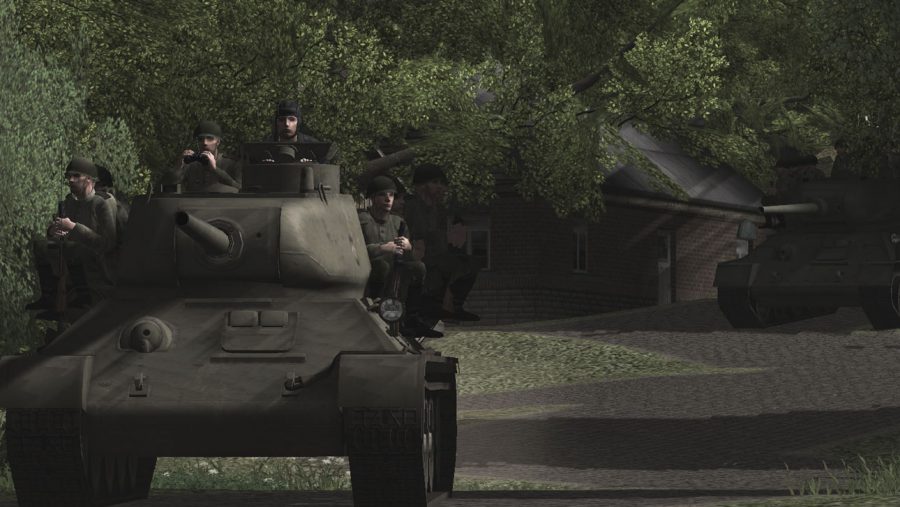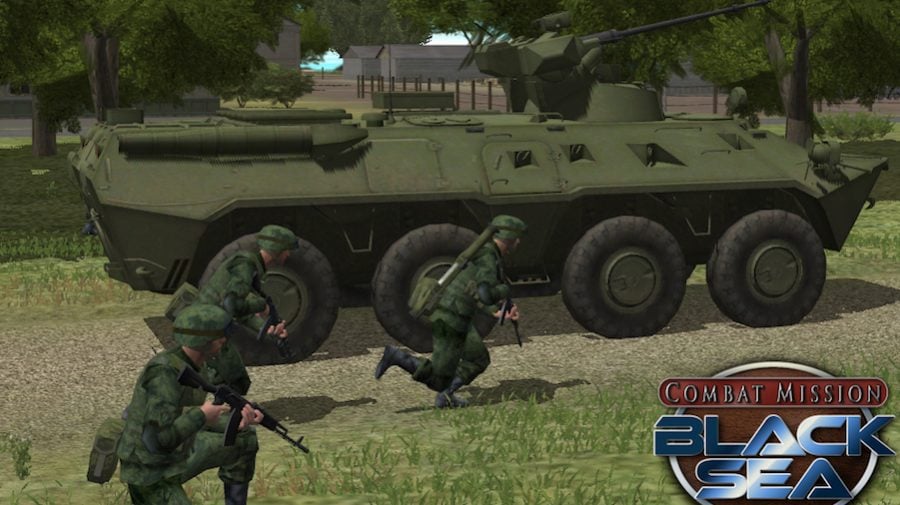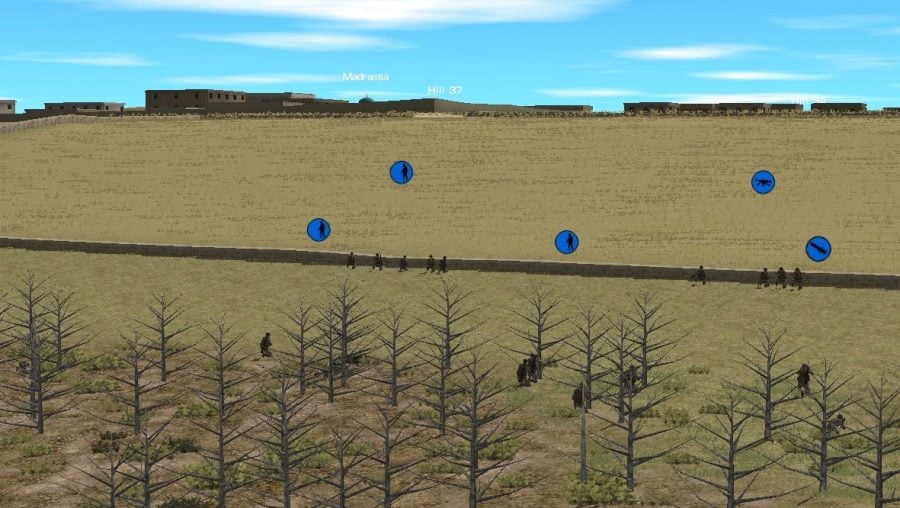The Combat Mission (CM) series stretches back some twenty years. On the surface it’s an unlikely success story. A deep tactical battlefield simulator with average graphics, a hefty price tag, convoluted patching system and availability through a niche storefront. And yet, like all great games, it is carried by its gameplay.
For all its faults, and there are a few, it is still one of the deepest tactical battlefield simulations available. Consequently, CM has seen eleven separate releases, multiple expansions, and has kept its fans coming back to the battlefield for some two decades.
When Slitherine/Matrix announced it was bringing Combat Mission: Shock Force 2 (CMSF2), onto Steam, it seemed like the perfect time to go back and take a look at this long-running series. After all, there’s bound to be a few fresh faces discovering CM for the first time. If you are on the fence about trying out a CM game, hopefully this guide can help you. Older players should find the guide useful in identifying what upgrades are available and what paid upgrades are needed to play specific DLC (more on that below).
Combat Mission Series
There are eleven games in the CM series, many of which have additional DLC:
- Combat Mission: Beyond Overlord (CMBO)
- Combat Mission II: Barbarossa to Berlin (CMBB)
- Combat Mission III: Afrika Korps (CMAK)
- Combat Mission: Shock Force (CMSF)
- Combat Mission: Afghanistan (CMA)
- Combat Mission: Battle for Normandy (CMBFN)
- Combat Mission: Fortress Italy (CMFI)
- Combat Mission: Red Thunder (CMRT)
- Combat Mission: Black Sea (CMBS)
- Combat Mission: Final Blitzkrieg (CMFB)
- Combat Mission: Shock Force 2 (CMSF2)
It is also important to note that there are two proprietary engines upon which CM games have been built (CMx1 and CMx2). CMSF, and all subsequent games, use CMx2. This is important because games built on the CMx2 engine are essentially the same game set in different eras or theatres of war. As new games were released and new features added to the CMx2 engine, Battlefront opted to retroactively upgrade the older CM games (bringing them in line with the latest engine standards), via paid upgrades. Consequently…
Patches are free but engine upgrades cost money
Like most developers, Battlefront release patches with balance adjustments and bug fixes—these can be downloaded for free (sort of). Unlike most developers, Battlefront retroactively upgrades older games in the CM series. Rather than abandon the old titles, or re-release them, Battlefront offers paid upgrades which bring the older games in-line with the latest engine enhancements.
As of writing the latest engine upgrade is engine 4.0. Upgrade costs vary depending on the engine version you upgrade from (CMBFN and CMFI need you to upgrade to engine 3.0 and then 4.0). As a rule of thumb, upgrades cost between $10-$15 USD. There are currently five titles that can be upgraded. There is also an option to purchase the upgrade for all five titles (as a $25 USD bundle). Sounds confusing? It is. But this page will help.
Taken together, patches and engine upgrades blur the line between free and paid updates. Battlefront does offer free bug fixes and balance changes but once an engine upgrade occurs, support for the old version stops. If you have engine 3.0 for CMBN and you wanted to install the latest patch for the game (4.03), you would first need to purchase engine upgrade 4.0, then download the free 4.03 patch. Consequently, if a bug is fixed in a patch that falls under a newer engine, you essentially have to pay for a bug fix.
To make matters even more convoluted nearly all the DLC/expansion modules have different prerequisites (these have all been listed below). Some DLC requires you to also purchase the engine upgrades in order to function. Others require that you own other DLC modules. Consequently, not only are things confusing but things now cost more than you may have initially thought.
In theory, paying for a significant engine upgrade, instead of re-releasing an older title, is not a bad idea. However, the patch notes for the 4.0 upgrade look anaemic. To be fair, there may be a lot of ‘under the hood’ changes, but they are not listed in the patch notes. Either way, Battlefront’s patching policy ruffles a lot of feathers (including some of us here at Wargamer) and it’s something to be aware of when buying into the series.
Note: At the time of writing, this patching policy is not an issue for new players. If you purchase any CM game now, you will receive the latest version and therefore are not required to pay for the previous engine upgrades. However, should there be further development of the CMx2 game engine, users will almost certainly be required to pay an upgrade fee—this is a separate purchase for each of the games you own.
Buy Combat Mission for the gameplay, not the graphics
Graphics in Combat Mission are not going to win any awards, they are adequate at best—with the original three games feeling extremely dated. The models themselves look reasonably detailed, especially vehicles. However, unit animations are clunky throughout. Here’s the thing though: the gameplay is so solid that the graphics fade into the background. The tactical engagements are so intense that not even the clumsy soldier animations can break the game’s immersion. What the game aims to do it does well.
Try the WEGO mechanics before using the real-time option
The original trilogy of CM games used a turn-based hybrid system, dubbed ‘WEGO’. Each turn, orders were issued to units by both players. Those orders were then executed simultaneously during a sixty second real-time window, at the end of each turn. With the release of CMSF, and the upgraded CMx2 engine, Battlefront added the option of playing CM as a pausable real-time experience. Personally, I enjoy both options. However, this game was designed to be played using the WEGO system. That’s because, WEGO partially simulates the command and control challenges faced by commanders.
Under the WEGO system you are forced to cede control of your units to virtual commanders (dubbed TacAI), as they attempt to carry out your orders. You cannot react to the battlefield situation in real-time, depriving players of their ‘gods-eye’ view of the battlefield. It forces the player to make decisions based on incomplete information as you cannot instantly react to your opponent’s movements. In this way, WEGO merges the tactical depth and planning of turn-based gameplay with the intensity of real-time systems. Whilst it might not be for everyone, it does add an extra layer of realism to the overall experience and is worth trying out.
Don’t be put off by early failures and the steep learning curve
Combat Mission is a difficult series to master and you are going to fail… a lot. What works in other games is unlikely to work here. That’s because CM positions itself as a tactical simulation of the battlefield. There’s an emphasis on using basic military principles, such as laying down suppressive fire when assaulting positions.
Understanding the game’s mechanical nuances is another problem to overcome. For example, there are multiple types of movement commands that can be given to units: move, quick, fast, slow, hunt, assault, blast and reverse. Each of these does something slightly different. You can think of this as something similar to what the Close Combat series does.
A good way to start unpacking the engine is to check out the Combat Mission: Tactics, Techniques, and Procedures series on YouTube. And whilst the videos in that series use Battle for Normandy, most of the tips and tactics are applicable to all CM games.
COMBAT MISSION MODS
Battlefront has always had a very active modding community, although you’re not going to find complete overhauls or new theatres of operations. But you will find new sound effects, scenarios and campaigns to extend gameplay. In terms of graphics, you will find re-skinned infantry, vehicles, tanks, foliage and trees. Shaders can also be manipulated to increase the graphical fidelity of the game. The results can be pretty significant. Check out YouTuber SmartWargames, to see just how game changing these mods can be—along with instructions on the shader settings he uses.
Battlefield upgrades: Check out our guide to the best Arma 3 mods
Finding mods for the original trilogy of CM games can be a little difficult. Luckily, GreenAsJade has pretty much everything you could want with over 5200 mods available on the one website. AlternateWars has a few thousand scenarios that can be downloaded in three handy downloads (one for each game). Similarly, The CM Mod Warehouse has mods for all of the CM games built on the CMx2 engine and The Scenario Depot has scenarios covered.
Combat Mission Games – Which one to get?
As mentioned above, games in the CMx2 engine are nearly identical in terms of features. The divergence in gameplay comes down to the differences in units, terrain and weapons. Ultimately, your choice of which game to buy should be guided by the period and theatre you are most interested in.
Combat Mission: Beyond Overlord
The original game that kicked off the series, CMBO was released in 2000. It recreates battles throughout north-western Europe—from the D-Day invasion through to the end of the war. Critically, the game was well received and broke the mould of the turn-based-hex wargames that preceded it. The chit or miniature representations on grid-based battlefields, that dominated the genre, were replaced with 3D graphics and a hybrid turn-based/real-time (WEGO) system—used to propel the action.
Graphically, this game has not aged well and with newer versions based within the same theatre, there really is no reason to pick this one up. But if you really wanted to, GOG has a digital version available.
Combat Mission II: Barbarossa to Berlin
The second instalment in the CM series and the title that started my love affair. Barbarossa to Berlin was released in 2002, again to positive reviews (89 on Metacritic). The action was moved to the Eastern Front and covered theatre operations from 1941-1945. Minor nations were also represented with Italian, Hungarian, Romanian and Finnish forces filling out the OOB.
Graphically the game received a hefty upgrade, sound was improved, and a host of new features added. Given the theatre of operations, armour also received a lot of work.
By the time you add mods and player-made scenarios, it offered wargamers huge amounts of gameplay in one deep and engaging package—that looked pretty good for its time. Also available via GOG.
Combat Mission III: Afrika Korps
The final game developed on the CMx1 engine. CMAK was released in 2004 and moved the action to the Mediterranean. Battles take place across Crete, Italy and North Africa from 1940-1945. Essentially the same game as CMBB, critics were a little disappointed that the weaknesses of the previous game had not received any attention. This would be a common gripe with players across the entire CM series.
At $5 USD a piece, picking up CMBB or CMAK is a cheap way of seeing whether you like the style of gameplay on offer by the series. Later titles add more features, increase graphical fidelity and add a playable real-time option to the landscape, but the underlying gameplay loop remains the same.
Essentially, if you don’t like these games the CMx2 engine is not going to change your mind. As mentioned above the CMx2 game engine represents an evolution in gameplay rather than a revolution. Available from GOG.
Combat Mission: Shock Force (Unavailable)
CMSF changed things up when it was released in 2007. It utilised a new game engine (CMx2), moved combat from World War II to the modern era and made some graphical upgrades. It also modelled infantry on a 1:1 scale whereas CMx1 based games modelled infantry on a 1:3 ratio. Based on a hypothetical US invasion of Syria, CMSF is generally praised for its new setting. However, that’s where the praise tended to end. The AI was weak, there were path-finding issues, balance issues and bugs—which led to multiple patches.
Three ‘modules’ (Battlefront’s version of DLC), were released, adding British, NATO and Marine forces. A direct sequel was released in 2018 with significant improvements. Consequently, the original is currently unavailable for purchase.
Note: Owners of CMSF get a heavy discount if they upgrade to CMSF2.
Combat Mission: Afghanistan
CMA is something of an anomaly. It was developed under license by Russian developer Snowball. It covers the Soviet-Afghan War, focusing on two distinct periods: 1980-1982 and 1985-1987. There are two campaigns and fifteen scenarios. Outside of the unique era and setting there really isn’t much in the way of new features. Whereas Battlefront has continued to upgrade CMx2 based games over the years, all active development of CMA has ceased—there are no engine upgrades available. Available directly from Battlefront.
Combat Mission: Battle for Normandy
CMBFN returns to the series’ roots. Released in 2011, it takes players back to the bocage of north-western France: from the Allied D-Day landings in June through to Operation Cobra in August. It’s the usual fare of scenarios and campaigns. Our review did note a beefed up AI, though other reviewers seem to disagree—noting that the various issues that plagued CMSF were still present in CMBFN.
Available from Battlefront and has the following expansions:
- The Commonwealth Forces DLC adds British, Canadian and Polish forces for the Allies. The Waffen SS are added to the Axis OOB. The new forces require new tactics and playstyles, highlighting one of the strengths of the CMx2 engine and the series as a whole. Two new campaigns and around twenty scenarios round out the package.
- The Market Garden DLC is fairly self-explanatory. Two campaigns, fourteen scenarios and a huge number of new units to better represent the forces deployed during the campaign.
- Note: Market Garden requires game engine 2.0 or above to function.
- The Vehicle Pack DLC is a smaller module bringing some odd vehicle configurations to the game.
- Note: For full functionality, the Vehicle Pack requires both the Commonwealth Forces and Market Garden DLC. Game engine 3.0 or above is also required to function.
- Finally, Battle Pack 1 covers combat between the Normandy campaign and Operation Market Garden.
- Note: For full functionality, Battle Pack 1 requires the Commonwealth Forces, Market Garden and Vehicle Pack DLC. Game engine 3.0 or above is also required to function.
Combat Mission: Fortress Italy
CMFI was released in 2012. Based on the CMx2 engine it received further development in what would be the first of the paid engine upgrades—under the 2.0 moniker. The updated engine added bump mapping, new shaders, improved framerates, and a pausable real-time TCP/IP mode—along with other small upgrades. These features could all be added to CMBFN for a nominal fee. As for CMFI, the base game depicted Operation Husky—covered through four campaigns and seventeen scenarios. Forces were limited to American, German and Italian formations. Expansions would continue the Italian campaigns all the way up the boot of Italy. Available from Battlefront with the following expansions:
- The Gustav Line DLC added Commonwealth forces (United Kingdom, Canada, Poland, and New Zealand), to the base game’s Sicily campaign. It also added units, across all factions, to cover battles such as Salerno, Anzio and Monte Cassino—ending with the capture of Rome in June 1944. Four more campaigns, eighteen scenarios and various additional maps to use in the Quick Battle mode, round out the addon.
- Note: The Gustav Line requires game engine 3.0 or above to function.
- Rome to Victory continued the march from Rome into the Alps. Two more campaigns and eight scenarios were added, along with Indian, Brazilian, South African and Free French forces to pad out the Allied OOB. The Axis received some Waffen SS and Luftwaffe formations.
- Note: Rome to Victory requires game engine 4.0 and patch v2.10 to function. The Gustav Line Module is also recommended for full functionality.
Combat Mission: Red Thunder
CMRT was released in 2014. The game engine received another paid upgrade, taking it to version 3.0. TCP/IP connections could now play out battles using the WEGO system. Hit decals were added to vehicles, ground to air combat was added, load times improved, and there were some graphical upgrades—in the form of new shaders.
The game itself represents combat on the Eastern Front from the start of Operation Bagration in June ’44 to the fall of Berlin in 1945. I originally thought it unlikely (at this point in the game’s life-cycle), that it would receive an expansion. However, Fire and Rubble, which has been in development for a very long time, seems to still be in development—though no release date has been set as at time of writing. You can follow the expansion’s progress here. Available from Battlefront.
Combat Mission: Black Sea
Another 2014 release, CMBS returned to the modern day with a fictional conflict set in 2017. Somewhat of a coincidence, the game portrays a conflict between NATO and Russian Federation forces over Ukraine (the story for CMBS was developed in 2009 before the very real conflict that took place in Ukraine in 2014). New features such as electronic warfare, UAVs and night vision, were added to better represent modern warfare. It doesn’t stray far from the series’ successful formula. Available from Battlefront.
Battle Pack 1 for CMBS adds two new campaigns, six scenarios and some new maps that can be used in the Quick Battle game mode.
Note: Battle Pack 1 requires game engine 4.0 to function.
Combat Mission: Final Blitzkrieg
CMFB was the last game to use the 3.0 version of the CMx2 engine. It focuses on the American sector of the Battle of the Bulge from October ’44 through January 1945. Like CMRT, Battlefront implied that there would be some expansions but that has not panned out. Available from Battlefront.
Combat Mission: Shock Force 2
The latest CM game, Shock Force 2 was released in December 2019. Once again the series returned to modern warfare, modelling a hypothetical war between a Western coalition and Syrian forces. CMSF2 serves as an upgrade to the original CMSF—bringing the original title into game engine 4.0. The original three expansions were also remade. Available from Battlefront and Steam.
- Marines adds formations from the US Marine Corps along with Syrian Airborne forces which are armed with Russian equipment. A new hypothetical campaign is added—a Marine led invasion from the Mediterranean into the Syrian interior. Sixteen scenarios round out the offerings.
- British Forces includes a range of heavy and light forces from… Britain. The US also gets some more weapons and equipment to round out their forces.
- NATO Countries adds Germany, Canada and the Netherlands to the game. Each of the combatants utilise different tactics, in line with the significantly different weapons and equipment available to each countries’ forces.
And there you have it – a complete guide to the Combat Mission series. Love it or hate it, it’s an important touchstone of digital wargames and we hope the company’s move to Steam opens up some new options for the games.
